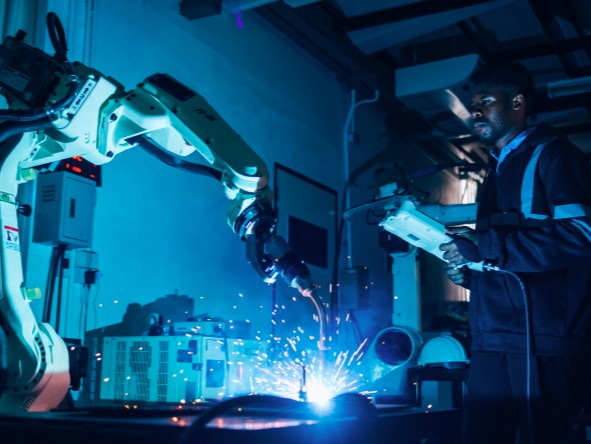By Patti Gander for AssuredPartners
The manufacturing industry has continued incorporating automation and robotics into its manufacturing processes. Although there are several reasons for this transition, some key driving factors are increased productivity, greater efficiencies, and overall improved quality.
Additionally, the manufacturing industry, like many other industries, struggles to find people to fill the job vacancies.
As robots become more flexible and collaborative, they are being implemented to work cooperatively and safely with operators. Robots are capable of handling complex tasks and can easily be adapted to changes in production requirements. Robots are even being integrated with other technologies, further enhancing their capabilities and enabling real-time data analysis for optimization.
Included in the manufacturing industry’s move towards a greater emphasis on technology is the use of automation. Intelligent systems will automate supply chain management, inventory control, logistics, and quality control processes. The use of autonomous vehicles for material handling and delivery will become more prevalent.
How will the move towards robotics and automation change manufacturing? The changes to the manufacturing industry are expected to be significant and will be evident in several ways:
1. Increased productivity: Automation and robotics will allow for a more streamlined and accelerated production process, leading to higher output and increased productivity. Robots can work continuously without fatigue, perform repetitive tasks with a high degree of precision, and can complete operations faster than human workers.
2. Improved efficiency: When accurately programmed, automation can eliminate human errors, reduce waste, and optimize resource utilization. Robots can operate at consistent speeds and execute tasks with minimal variability, resulting in improved efficiency and consistent and reliable quality.
3. Enhanced safety: Robots can be employed in hazardous or physically demanding environments, reducing the risk of accidents and injuries to human workers. By taking over dangerous tasks, automation improves workplace safety and promotes a healthier work environment.
4. Cost reduction: The initial investment for implementing automation and robotics can be significant but can lead to long-term cost savings. Automated systems can operate 24/7, reducing labor costs, minimizing production downtime, and optimizing energy consumption.
5. Customization and flexibility: Advanced robotics technologies enable agile and flexible manufacturing processes. Robots can be programmed and reconfigured quickly to adapt to changing production requirements and handle various product designs, sizes, and materials. This allows for greater customization and responsiveness to customer demands.
6. Data-driven decision-making: Automation systems generate vast amounts of data that can be analyzed in real-time. Manufacturers can leverage this data to monitor and optimize processes, identify inefficiencies, and make data-driven decisions for continuous improvement.
7. Workforce transformation: The integration of automation and robotics will lead to a transformation in the workforce. While some job roles may be displaced, new positions will emerge that require skills in operating, programming, and maintaining automated systems. The workforce will need to upskill and adapt to work collaboratively with robots and advanced technologies.
The implementation of automation and robotics is not without challenges, such as the cost, which can be high, job displacement of employees currently providing those operations, increase in maintenance and maintenance cost, and the need for different technical expertise in both programming and maintaining the robotics and automation.
Overall, the outlook is that manufacturing will witness an increase in its adoption of automation and robotics. This transformation will lead to increased productivity, improved efficiencies, enhanced safety, cost reduction, greater customization and flexibility, and data-driven decision-making. It is important to note that the human worker will continue to have a crucial role in overseeing and managing automated systems, focusing on tasks that require creativity, problem-solving, and decision-making abilities.
Contact AssuredPartners Manufacturing for additional insights.
Share this Post

